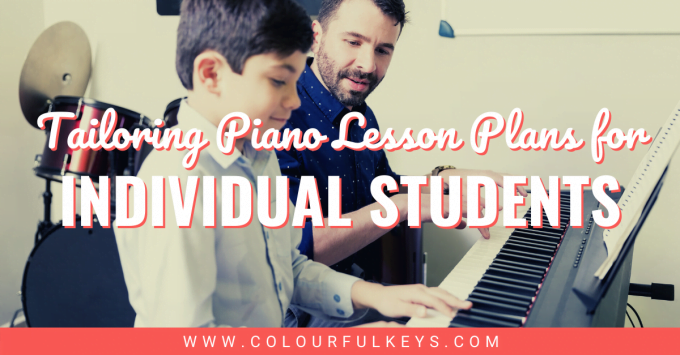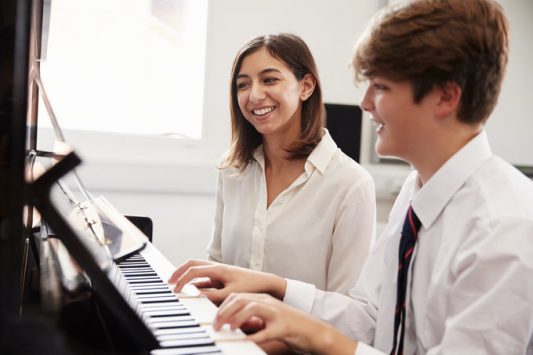I’m pleased to share with you Dana McCabe’s approach to lesson planning based on piano student learning styles and musical interests. Dana is a piano teacher in Beaverton, Oregon, USA. She spent 20 years teaching elementary music and early childhood in the classrooms of Central Minnesota before moving west and opening her piano studio. Dana has two wonderful teenage stepsons, and the whole family enjoys trips to the Oregon Coast and Mount Hood. Other than teaching, her favorite things are her family, reading, yoga, wine, and introverting quietly. Enjoy! – Nicola 🙂
“You’re nothing like your sister!”
“Why can’t you be more like your brother?”
How many of you heard these types of comments from your older sibling’s teachers, or from the neighbors? I guess I didn’t much, because I’m the oldest (and a people-pleaser). But my poor younger sister heard it ALL the time.

Granted, we were children in the 1970s in a small midwestern town and that kind of thing was pretty typical, but it sure made an impression on her.
Not a good one.
I’ll bet you can think of sibling pairs you teach who are vastly different from each other. Or two students who are in the same classroom at school, the same age, but they are also very different from one another.
In fact, I would bet we as teachers have a hard time coming up with two students in our studios who are super similar. Why, then, would we assume that one way of teaching is good for every student we encounter?
Over the last 30 years, my style of teaching has evolved and changed. I used to use a single method book series. During the lesson I would listen to what I had assigned, tell them what needed fixing, and assign new pages.
I didn’t plan lessons in advance or incorporate anything beyond the method books.
Hah! Those early students wouldn’t recognize me as their teacher anymore! Now, I plan my lessons and include materials from the Vibrant Music Teaching Library and other sources to create fun and engaging lessons.
Lesson Planning Inputs
When planning lessons for my students, I keep two things in mind:
- What music my students love to play
- How my students best process information
Music My Students Love To Play
There is so much music in the world! Jazz, new age, pop, rock, musicals, movie music, video game music, country music, folk music, just to name a few. And of course, the vast and varied world we put under the umbrella of Classical Music.
Each fall when lessons begin, I ask my students what music they have been listening to and what they love.

I usually get the typical responses like Taylor Swift, hard rock, or country.
But I’ve also been surprised by students who like opera or jazz, and one student who likes dragon music. Yep, dragon music.
I have found that when my students are playing music they LOVE (yes, all caps L-O-V-E,) they practice more often and much more efficiently. So every student in my studio plays music that they LOVE.
That doesn’t mean that I don’t introduce new music or styles or pieces to them. It just means that they get to have some ownership over their repertoire, and that makes for happy students.
Happy students = great learning.
Happy students = happy parents = happy teacher.
And who doesn’t love a whole lot of happy?
Piano Student Learning Styles
I’ve long been interested in the work of American developmental psychologist Howard Gardner and his Multiple Intelligences theory. He outlines eight “intelligences”, or ways people process information:
- musical – rhythmic
- visual – spatial
- verbal – linguistic
- logical – mathematical
- bodily – kinesthetic
- inter-personal
- intra-personal
- naturalistic
We each possess all eight of these intelligences, but one or two will naturally dominate as our preferred way of taking in information.
Every single student needs to (and does) learn music in multiple ways. In fact, we all learn in all ways. It is how we best process information that matters.
Different Teaching Strategies for Different Learning Styles
To help my students learn in many ways, I think about different ways to approach teaching for different piano student learning styles:
Musical – Rhythmic: creating patterns, humming; play on a different instrument.
Visual – Spatial: Highlight scores, associate musical eras to the art and architecture of that era, often more white space in a score is helpful, thinking in intervals.
Verbal – Linguistic: theory books and worksheets, lyrics, rhythmic words, writing, journaling, reading about music.
Logical – Mathematical: The symbolic nature of music is natural here. Score analysis, rhythmic and melodic pattern recognition, and a visual lesson plan.
Bodily – Kinesthetic: Move, clap, tap, dance, and conduct. Use the Kodály hand signs for Solfa.
Inter-personal: Group learning, cooperative work, partner and buddy lessons. Individual students can collaborate with others virtually.
Intra-personal: Fewer visual distractions, practice with eyes closed, journaling and individual goal setting, internal beat games.
Naturalistic: Step outdoors, observe bird song, find patterns in nature, learn music with nature themes.
Psst…Want even more ideas about different teaching approaches? Check out Nicola’s centralized “Planning Piano Lessons” page.
Seeing it in Practice
To understand how different piano student learning styles influence my planning for students in real life, here are a few of my students and how I approach their lessons (names changed).

TREVOR is 13, has taken lessons for five years, and plays what he wants to play. I have given him many books and collections that I think he’ll like, and he’ll play through them in their entirety, then choose the pieces he wants to tackle.
If I try to assign a piece for Trevor to learn, it will take him weeks. If he chooses a piece, it takes him days. He also prefers to not play too many theory games and he isn’t too interested in my Studio Challenge Board. He is very much a musical – rhythmic processor.
VERONICA, age 12, prefers more structure, so I choose pieces for her to work on. It takes her longer to learn them, but she is happy with her progress.
She likes the occasional game, always does her written work, and loves the Studio Challenge Board. Veronica thrives with a visual – linguistic approach to learning
CORY, age 15, has been taking lessons for six years. He isn’t much of a practiser, but he’s making progress. He likes musicals and music from movies and video games.
Not much interest in playing games (but he’ll participate if encouraged.) He works to achieve his goals on the Studio Challenge Board.
Cory is a mostly logical – mathematical learner with some visual – spatial tendencies.
Lesson Planning Outputs
Now, you might be wondering how on earth I plan for my students and keep everything straight.
I’ve tried spreadsheets and word documents, but what works best is just an overall (but well organized) list for each student. And a lot of post-it notes.
Each student has a section in my daily binders and a planning page which just lists the skills, pieces, books, games, challenges, etc. which I want that student to accomplish for the year.
I revisit the list monthly/weekly, and revise it quarterly. When something is accomplished, I cross it off or make notes on how to expand on it.
If you’re still struggling to land on a lesson planning output which works for you, Nicola has shared 3 useful lesson plan types in this article.
How do you plan?
In the comments below, I’d love to hear how you plan for the individuality of each student and what parameters you use. Maybe you’re still in the place where you use one method book or using them in many different ways, and that is all okay! This is just where I am on my journey right now.